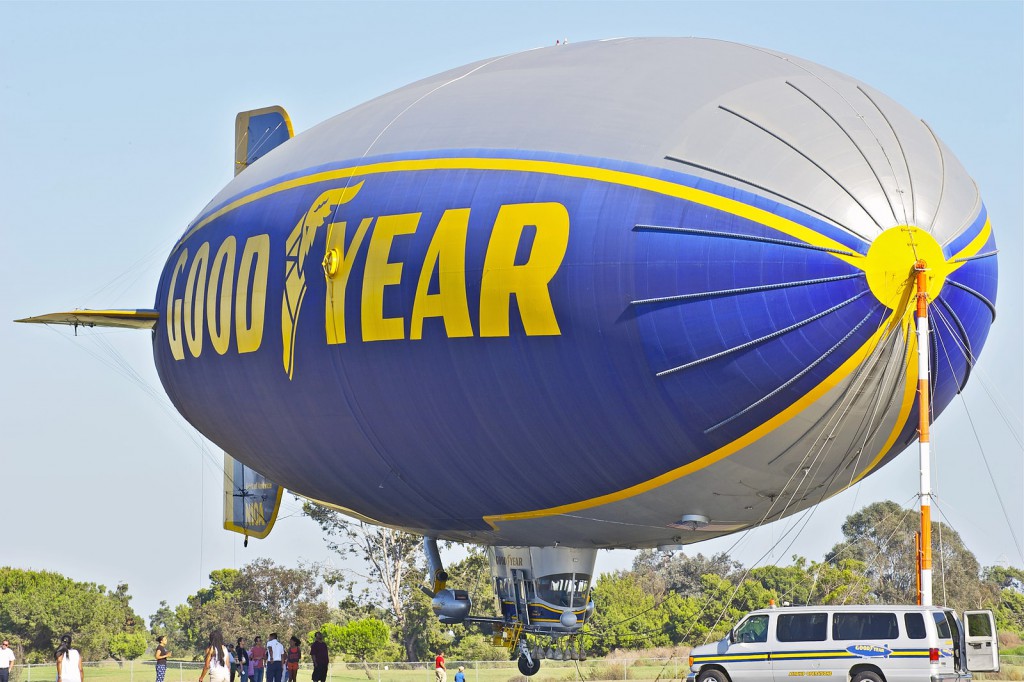
Aircraft manufacturer Aeros has announced its new Aeroscraft ML866 has officially entered production, and will be bigger than the Goodyear Blimp, featured above.
The Goodyear Blimp and the ill-fated Hindenburg might be the world’s most well-known dirigibles, but that could change if a Montebello, Calif., company’s plans get off the ground. Aeros has announced its Aeroscraft ML866 has officially entered production.
The Aeroscraft ML866 is poised to become the world’s largest aircraft. The rigid-form dirigible is under development to provide an alternative to traditional airplanes and ships for cargo transport. Offering several attractive and unique qualities, the craft is anticipated to lend itself well to military operations and emergency relief efforts.
While the day of large-scale dirigibles was believed by many to have crashed with the Hindenburg back in 1937, that’s simply not the case. Although the New Jersey fire and crash that killed 36 grounded efforts to create passenger airships, the industry has more or less remained constant. There are, in fact, three different kinds of dirigibles in existence today:
- Blimps – This craft, much like Goodyear’s famed flyer, lacks an internal structure and must be inflated like a balloon.
- Semi-rigid – This type of airship is also inflated, but does have some internal structure to balance loads.
- Rigid – Airships like Aero’s ML866 have a defined framework that keeps airships’ structure whether they’re inflated or not.
The roots for Aeros were planted in 1981 when its founder Igor Pasternak created an all-volunteer design bureau at Lviv Polytechnic University in the Ukraine. By 1987, the company launched its first production line of tethered aerostats. It relocated to the United States in 1994 and shortly thereafter began developing systems for the U.S. Department of Defense.
You Might Also Enjoy: Delta Customers May Soon Get to Take a Private Jet
The company has since logged a number of advancements, including earning recognition from the U.S. Federal Aviation Administration for its successful demonstration of ability to control buoyancy in flight.
Aeros’ breakthroughs have paved the way for the ML866. Unlike the Hindenburg that relied on highly-flammable hydrogen for its lifting gas, the Aeros model – like all modern airships – uses helium. While the lift isn’t the same, the gas will not ignite. Other features that make the Aeros model of particular interest in the aviation and military arenas include:
- Its payload size – This comes in at 73 tons, which is less than the largest cargo planes. Even so, the ship’s length will enable it to carry items other craft cannot, such as commercial turbine blades.
- Its overall size – Once in the air, the ML866 will be the world’s largest cargo aircraft, measuring in at 555 feet in length and 120 feet in height. It will also have a 177-foot wingspan. Those measurements make it bigger than a regulation size football field.
- Its buoyancy control – The Aeroscraft design boasts some features in this department that other airships cannot compete with. It does not require external ballast to stay in place for ground operations. The system is designed to compress its helium gas and pull in environmental air to enable the craft to stay put without weights added.
- Its flight abilities – While the craft will only enjoy a maximum altitude of about 12,000 feet and has a cruising speed around 115 mph, it can pull off a vertical takeoff and landing much like a helicopter. That means it delivers the versatility needed for military and relief operations into terrain other aircraft simply cannot venture into.
How soon the Aeroscraft ML866 might take flight remains unclear. What is clear is that Aeros is out to reimagine air travel and it has a track record of success that could very well put dirigibles back on the map.





